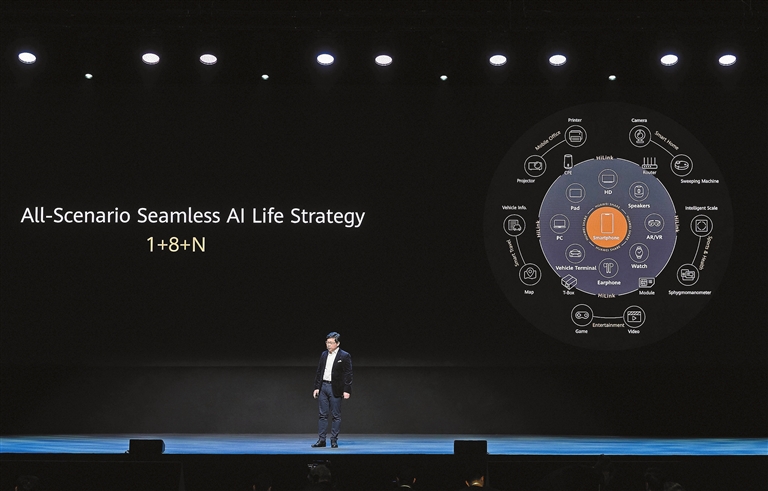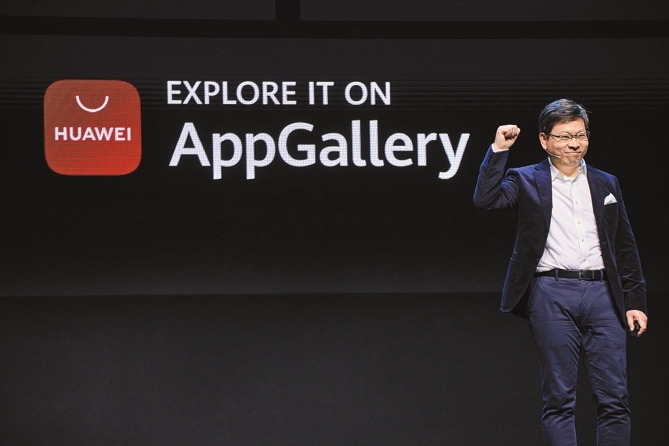

AS smartphone hardware design becomes increasingly similar, phone makers are striving to stand out ahead of the competition through their 5G offerings. Huawei is taking 5G development in its stride and now turns its attention to becoming a leader in creating an All-Scenario Seamless AI Life for its users. 5G products At the beginning of 2020, Richard Yu, CEO of Huawei Consumer BG, announced a range of new 5G flagship products for an all-scenario smart experience. This includes the HUAWEI Mate Xs, the upgraded version of the hugely successful Mate X, the new flagship 5G tablet the HUAWEI MatePad Pro 5G, the HUAWEI Wi-Fi AX3 featuring incredible speed and performance, followed by the HUAWEI 5G CPE Pro 2 which is the smallest 5G router to offer full frequency bands and the fastest connection. Both the HUAWEI Wi-Fi AX3 and HUAWEI 5G CPE Pro 2 are powered with Wi-Fi 6+ technology. Among them the HUAWEI Mate Xs is the most exciting to consumers, bringing upgrades in screen, hinge design, 5G performance and camera setup over the previous generation. Following its announcement, it has widely been praised as the most advanced and innovative smartphone ever by netizens. Ecosystem building Product development is just one of the motivations that drive hardware innovation. Arguably, 5G is the key to stimulating all kinds of information infrastructure and new drivers. Its most important capability is the ability to make everything connected in an ecosystem. As for end devices, they are not separated or isolated from each other anymore. The smartphone is no longer the single entry point to this ecosystem. As users rely more on technology, the smart home, mobile office, smart travel, fitness and entertainment are all important entrance points to a connected ecosystem. In 2018, Huawei Consumer BG officially announced its all-scenario smart ecosystem strategy, which was then upgraded to the All-Scenario Seamless AI Life Strategy in 2019. In 2020, Huawei continues to roll out this strategy to a worldwide market despite the difficult external environment the brand currently faces. The device ecosystem for Huawei’s All-Scenario Seamless AI Life comprises three layers of entry points. At the center is the mobile phone, which is used every day. The second layer includes eight entry points for specific scenarios such as Huawei watch, headphones, PCs, tablets, smart speakers, glasses, cars and smart TVs. The third layer is the “N” — the entry points to the IoT ecosystem — they are millions of smart products used for smart home, mobile office, smart travel, fitness and health and entrainment. In Huawei’s All-Scenario Seamless AI Life Strategy, the router, CPE, T-Box, modules and other connectivity products are the key connect 1+8 devices with equipment from the N ecosystem. They offer high-speed, stable and low-latency connections for all kinds of devices used by users in home and car scenarios. Together they bring a world like this: When doing exercise, users can enjoy sports without carrying a smartphone and their headphones can be connected to a smart watch to play music. Or in a car, the phone can be fully connected with the infotainment system, so that the user can do voice control and gesture control without holding the phone in hand. At home, a smart TV and AI speaker can be used as a smart assistant, helping you to control home appliances easily. The apps and content in the phone can be seamlessly displayed on a large-screen device and presented in high quality. At your workplace, the smartphone can use your laptop’s keyboard and mouse as peripherals, while files can be transferred between the phone and the laptop immediately and efficiently with a simple tap. Driven by All-Scenario Seamless AI Life, future devices can even “read your mind” and anticipate you before you make a request. For instance, when the doorbell rings, you can automatically see who is at the door on the connected smart TV. When you are asleep, your bracelet/band monitors your heart rate and body temperature. If body temperature fall is detected, your band can connect to the AC and adjust the temperature for you. When you get home, if you shake your shoulders or rub your arms, the camera will automatically recognize your movements and turn on the smart heating for you. Global developers Looking back on the big changes in the communication industry in past generations, first, the 1G analogue communication marked the beginning of the mobile communication era. The 2G digital signal communication made phone calls and SMS services become mature. With the introduction of smartphones, 3G network connecting mobile phones with Internet kicked off a new era of mobile Internet. The development of 4G mobile broadband then has revolutionized mobile Internet and brought drastic changes to consumers’ lives. Today, information technology, artificial intelligence, mobile communication and other new technologies are converging together, leading to the emergence of the fifth generation of mobile communication technology. Just like the delays with the 3G era, which first appeared in 2000 but was not fully rolled out until 2008, to fully roll out 5G, it not only requires revolution in hardware equipment, but also powerful software and apps. 5G is not just a redefinition of mobile services, it will also usher in a new era where open capabilities and technologies are used to drive the transformation of the telecommunication industry. In 2019, Huawei made the first breakthrough in its distributed technology, enabling different devices to be connected. Following this, in its recent launch event, Huawei officially announced the revamped HUAWEI AppGallery, which is developed based on the Huawei Mobile Services (HMS) ecosystem. “Today we have Google Play store and Apple’s App Store,” said Richard Yu, CEO of Huawei Consumer BG. “And the AppGallery from Huawei will bring you more choices.” In fact, Huawei’s smartphones have already earned global consumers’ recognition for technology innovations. Now, Huawei shifts its focus to its growing mobile app ecosystem. It’s not just about building a brand-new ecosystem but improving the existing AppGallery with technical upgrades, simple migration and service upgrades. Tapping into Huawei’s cutting-edge technologies as well as the approach of one single development for multiple devices, the new HUAWEI AppGallery is bringing about an all-scenario ecosystem. The HUAWEI AppGallery first launched in China in 2011, and the global version was officially released in April 2018. With nine years of experience in app distribution, HUAWEI AppGallery is now available in over 170 countries and regions, with 400 million monthly active users globally, covering mainstream apps and services in Europe, Latin America, Asia Pacific, Middle East, Africa and more regions for 600 million Huawei device users. It provides selected, high-quality apps to users and even covers all-scenario devices. In 2019, the store has enabled an astonishing 210 billion app downloads. This upgrade not only lowers the development barrier for all app developers, but also opens up new market opportunities, and more importantly, greatly improves consumer experience. For overseas consumers, the new HUAWEI AppGallery is like a new entrance for them to download apps. With technology development moving forward, what benefit does it leave for consumers? As Richard Yu said at the end of the launch event, “We believe technology should be open and available for everyone. Only in this way can we use technology to move the world forward, to create a better, connected world, and make everyone’s life better.” | 
